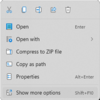I have two SSDs on my system - an "old-fashioned" SATA SSD and a "new" M.2 SSD that is plugged in to the PCIs x4 slot. Now, looking at the "Intel optane Memory and Storage Management" tool I find that the PCIs link speed is 4000 MB/s, while the SATA transfer rate is 6GB/s. The latter number looks bigger, and W11 installed on the SATA disk feels faster. Previously, I thought the PCIe would be faster, which is why I bought that SSD. Could someone please educate me on these issues? What I ultimately want to know, is to how to get the best out of the existing hardware.
My Computer
System One
-
- OS
- Windows 10
- Computer type
- PC/Desktop
- CPU
- i5-10600K
- Motherboard
- Asus Rog Strix Z490-A Gaming
- Memory
- 16 GB
- Graphics Card(s)
- GeForce GTX 1650
- Monitor(s) Displays
- Samsung U32J59x 32" 4K
- Screen Resolution
- 3840x2160





















